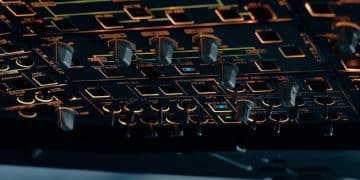Short Film Post-Production: The Ultimate Workflow Guide

Short Film Post-Production Workflow: A Comprehensive Guide to Editing, Sound Mixing, and Color Correction is crucial for transforming raw footage into a polished final product. This process encompasses editing to refine the narrative, sound mixing to enhance audio quality, and color correction to establish the visual mood, ensuring a compelling viewing experience.
Creating a short film is an exciting journey, but the real magic happens in post-production. This stage involves refining your raw footage into a polished, engaging story. Are you ready to dive into the world of editing, sound mixing, and color correction?
Let’s explore the essential steps of the short film post-production workflow: A comprehensive guide to editing, sound mixing, and color correction, ensuring your short film captivates your audience from start to finish.
Understanding the Editing Process
Editing is where your film truly takes shape. It’s more than just cutting and pasting clips; it’s about crafting a narrative, pacing, and emotional impact. Getting this part of the short film post-production workflow right is crucial to capturing and holding your audience’s attention.
Assembling the Initial Cut
Begin by organizing your footage and assembling a rough cut. Focus on the overall structure and storytelling, ensuring the key moments are in place.
Refining the Timeline
Next, refine your timeline by trimming clips, adding transitions, and adjusting the pacing. Look for opportunities to tighten the narrative and remove any unnecessary elements. The short film post-production workflow can be long, but the editing phase often demands the most patience.
- Trim excess footage to maintain a brisk pace.
- Use transitions sparingly to avoid distracting the viewer.
- Continuously review your work to identify areas for improvement.
The editing phase is where the story becomes clear. Consider different takes and angles to find the best way to convey your message. Proper editing is essential through your short film post-production workflow.

The Importance of Sound Mixing
Sound is half of the movie-going experience. Effective sound mixing can elevate your short film and immerse the audience in your story. Neglecting your sounds can detract greatly from even the best visuals of your short film post-production workflow.
Cleaning Up Audio
Start by cleaning up your audio tracks, removing any unwanted noise or distortion. This ensures that your dialogue and sound effects are clear and pristine. Sound mixing is an important detail in the short film post-production workflow.
Balancing Levels
Balancing audio levels is crucial for a consistent and comfortable listening experience. Ensure that all the elements of your soundtrack are at the appropriate volume, from dialogue to music to sound effects.
- Use noise reduction tools to eliminate hums and hisses.
- Pay attention to dynamic range to avoid sudden changes in volume.
- Collaborate with sound designers to create a cohesive and impactful mix.
Sound mixing is not just about technical adjustments; it’s also about enhancing the emotional impact of your film. Experiment with different soundscapes to create the right mood and atmosphere. The best sound mixing is nearly imperceptible but creates a powerful impact, as should the rest of your short film post-production workflow.
Color Correction for Visual Impact
Color correction is more than just making your film look pretty. It’s a powerful tool for storytelling, creating mood, and establishing a visual style. Good color correction can transform the visual appearance of the short film post-production workflow.
Establishing a Visual Style
Start by establishing a visual style that complements your film’s genre and tone. Consider the color palettes and grades that resonate with your audience. Consistency in color grades is vital to immerse the viewer during your short film post-production workflow.
Correcting Imperfections
Correct any imperfections in your footage, such as exposure issues or color casts. This ensures that your film looks polished and professional. Color correcting is vital for creating a good viewing experience in the short film post-production workflow.
- Use color wheels and curves to adjust hue, saturation, and luminance.
- Pay attention to skin tones to ensure they look natural.
- Experiment with different looks to find the perfect aesthetic.
Color correction is an art form that can significantly impact your film’s visual appeal. Whether you’re aiming for a vibrant, stylized look or a more naturalistic feel, color correction can help you achieve your creative vision. As with the other steps in the short film post-production workflow, careful planning is critical.
Integrating Music and Sound Effects
Music and sound effects are the unsung heroes of any film. They create atmosphere, heighten emotional impact, and enhance the overall viewing experience. Good music can elevate the short film post-production workflow to another level of visual experience.
Selecting the Right Music
Choose music that complements your film’s tone and narrative. Whether you’re using original compositions or licensed tracks, make sure the music fits seamlessly into your story. Getting the right music is vital to your short film post-production workflow.
Incorporating Sound Effects
Sound effects help to create a realistic and immersive soundscape. From subtle ambient sounds to dramatic explosions, every sound effect should serve a purpose and enhance the storytelling. It is important to properly use sound effects in your short film post-production workflow.

The goal is to create a cohesive and engaging soundscape that enhances the emotional impact of your film. Properly chosen music and sound effects make all the difference in the short film post-production workflow process.
Finalizing and Exporting Your Film
Once you’ve completed editing, sound mixing, and color correction, it’s time to finalize your film. This step ensures that your short film is ready for distribution and screening. Paying attention to these steps is essential for short film post-production workflow.
Creating the Final Master
Export your film in the highest quality possible to create the final master. This master will be used for creating distribution copies and archival purposes. Following these best practices enhances your short film post-production workflow.
Submitting to Film Festivals
Prepare your film for submission to film festivals by creating a digital cinema package (DCP) and a high-resolution QuickTime file. Each film festival has its own standards, as does the short film post-production workflow.
- Double-check that your film meets all technical specifications.
- Create a compelling trailer and promotional materials.
- Network with other filmmakers and industry professionals.
This is the final step of the short film post-production workflow: A comprehensive guide to editing, sound mixing, and color correction. With careful attention to detail, your short film is ready to be shared with the world.
Best Practices for Efficient Post-Production
A smooth and efficient post-production process can save you time and money. Here are some best practices to keep your project on track. Following best practices leads to a more efficient process in the short film post-production workflow.
Organization is Key
Keep your project files organized and backed up. Use a consistent naming convention and folder structure to make it easy to find what you need. Being organized is a virtue in the short film post-production workflow.
Collaboration is Essential
Collaborate with your team to ensure everyone is on the same page. Communication is crucial for a successful post-production process. Open communication makes the short film post-production workflow much more productive.
| Key Aspect | Brief Description |
|---|---|
| 🎬 Narrative Editing | Refine storytelling through precise cuts and transitions. |
| 🔊 Sound Mixing | Balancing audio and cleaning tracks to enhance the sound. |
| 🎨 Color Correction | Enhancing visual impact through color grading and style. |
Frequently Asked Questions
The first step involves organizing and reviewing all of the footage. This ensures that everything is properly categorized and ready for editing.
Sound mixing significantly impacts the viewing experience. It ensures clarity and balance in audio, creating a more immersive and engaging film.
Color correction enhances the visual appeal and sets the mood. Polishing the visual tone is vital for creating an effective and visually appealing film.
Common mistakes include poor audio levels and inconsistent color grading. Reviewing these elements ensures a professional-looking finished product.
A polished post-production process increases the chances of acceptance. Films with high-quality editing, sound, and color are more likely to impress.
Conclusion
Mastering the short film post-production workflow: A comprehensive guide to editing, sound mixing, and color correction is vital for transforming your raw footage into a compelling and captivating short film. Each phase offers unique creative abilities that elevate a film from script to visual art.
By following the steps outlined here, you’ll be well-equipped to create high-quality stories that resonate with audiences and stand out in film festivals. The process may seem like a lot, but it directly translates into the quality of your work.





